Can You Hike Torres Del Paine Without A Guide? Yes, you can absolutely explore the stunning landscapes of Torres del Paine National Park on your own. This article from CONDUCT.EDU.VN provides a comprehensive guide to planning a self-guided trek, ensuring a safe and memorable adventure. Discover essential planning tips, permit information, and navigation resources for an independent journey through Patagonia. This guide offers insights into self-sufficient trekking, solo hiking, and exploring Patagonian trails.
1. Essential Facts About Hiking the W Trek Independently
Before embarking on your self-guided adventure, understanding key aspects of the Torres del Paine W Trek is crucial for a safe and enjoyable experience. Here are some essential facts:
- Duration and Distance: The W trek typically spans 80 kilometers (50 miles), completed over four to five days. Plan your itinerary accordingly.
- Best Time to Hike: The optimal period for self-guided trekking is between October and the end of April. Winter months (May through September) necessitate a guide due to weather conditions. Contact Chile Nativo for winter tours; mention “Worldly Adventurer” for a 5% discount.
- Advance Reservations: Booking camping spots or dormitory accommodations in advance is mandatory. You might need to present these reservations upon park entry.
- Food Arrangements: You can pre-book full board at campgrounds, including dinner, breakfast, and a packed lunch. Alternatively, purchase supplies in Puerto Natales for self-catering.
- Fitness Requirements: A reasonable level of fitness is required, especially for climbing to the Frances Valley and the towers. Practice hikes with a 10-kilogram (22-pound) backpack are recommended.
- Park Entrance Tickets: Purchase your park entrance ticket online via pasesparques.cl before arrival, as on-site payments are no longer accepted. Download the QR code in Puerto Natales, where internet access is available.
- Park Entrance Fees: The cost varies depending on the length of your stay. For up to three days, it’s $31,200 CLP ($34 USD) for adults and $16,000 CLP ($17 USD) for children aged 12 to 17. Stays longer than three days cost $44,500 CLP ($48 USD) for both adults and children.
- Altitude Considerations: The highest point in the park is the John Gardner Pass at 1,200 meters (3,900 feet) above sea level, relevant only for those trekking the O Circuit. The W trek remains at lower altitudes.
2. Understanding the W Trek
The “W” is a popular multi-day hike in Torres del Paine National Park, named for its W-shaped route. It can be tackled from west to east or east to west, both offering stunning scenery.
- Why is the W Trek Worthwhile? The breathtaking views, ranging from Grey Glacier to the French Valley and the iconic towers, make the effort truly rewarding.
- Fitness Level: The trek is moderately challenging. If you can comfortably walk up to 18 kilometers (11 miles) per day for several consecutive days, you should find it manageable.
- The Towers Ascent: The final ascent to the towers is considered difficult due to a significant elevation gain of 900 meters (2,956 feet).
- Backpack Considerations: The weight of your backpack will depend on whether you carry your camping gear and meals or rent them along the way. Consider leaving your pack at designated areas before tackling steeper sections like the French Valley and the towers.
- Preparation: It is highly recommended to undertake practice hikes of approximately 18 kilometers (11 miles) with a weighted backpack before your trip. This will help you acclimatize and break in your hiking boots.
3. Estimating the Cost of a Self-Guided W Trek
Hiking the W independently is significantly more economical than opting for a guided tour. Tours can cost upwards of $1,500 USD per person, while a self-guided trek can be accomplished for a fraction of the price.
- Approximate Cost: Hiking the W independently can cost around $173 USD per person, excluding the cost of food.
- Campsite and Transport Cost Breakdown:
- Return bus from Puerto Natales to Torres del Paine National Park: $19 USD
- Park entrance fee (for over 3 days): $48 USD
- One-way ferry from Pudeto to Paine Grande: $45 USD
- Campsite fees: Vary depending on the site; approximately $11-40 USD per night
- Food Budget: Budget around $12 USD per person per day for food if you bring your own supplies.
3.1. Camping and Transport Cost Breakdown
| Item | Cost (USD) |
|---|---|
| Return Bus from Puerto Natales | $19 |
| Park Entrance Fee | $48 |
| One-Way Ferry from Pudeto to Paine Grande | $45 |
| Grey Campsite | $11 |
| Paine Grande Campsite | $13 |
| Francés Campsite | $40 |
| El Chileno Campsite | $40 |
| Total (Excluding Food) | $176 |
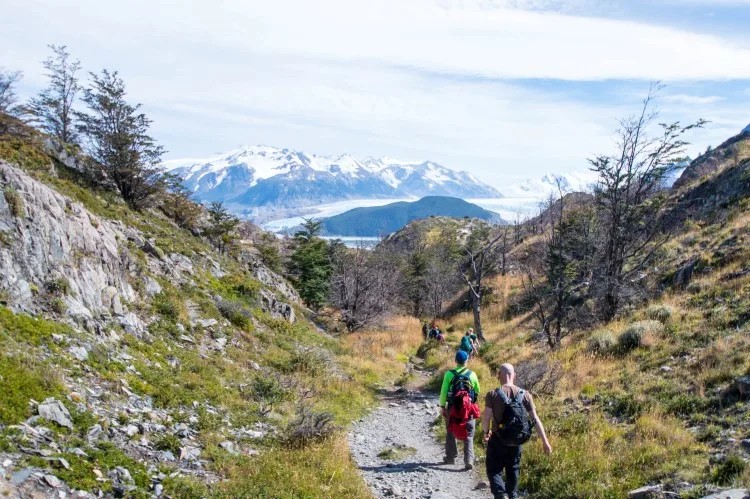
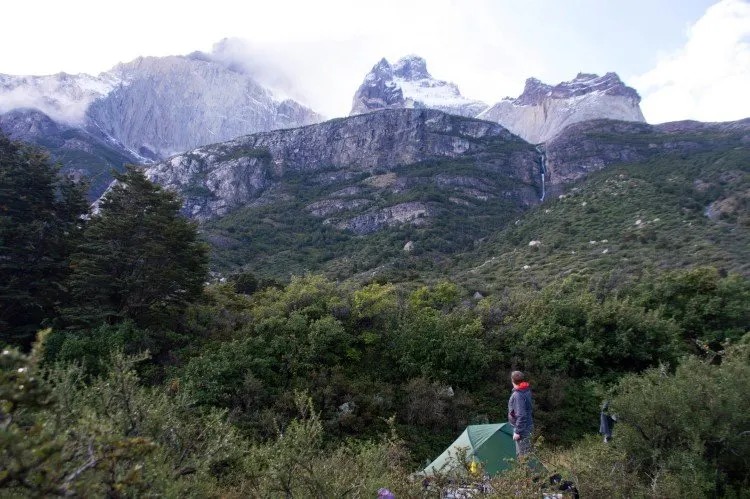
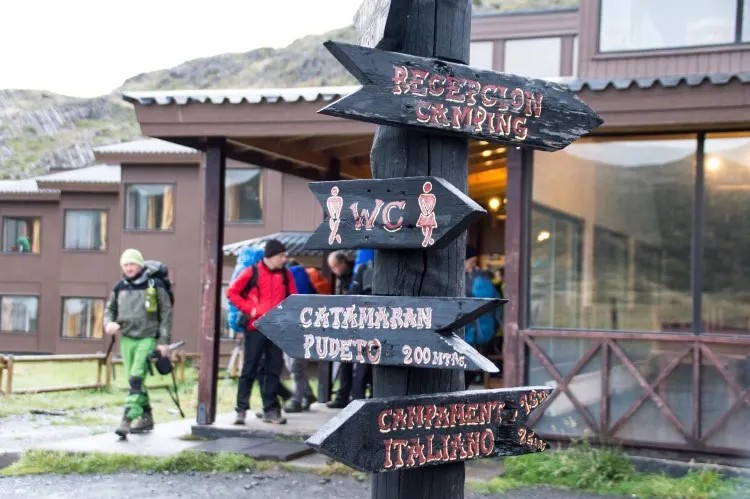
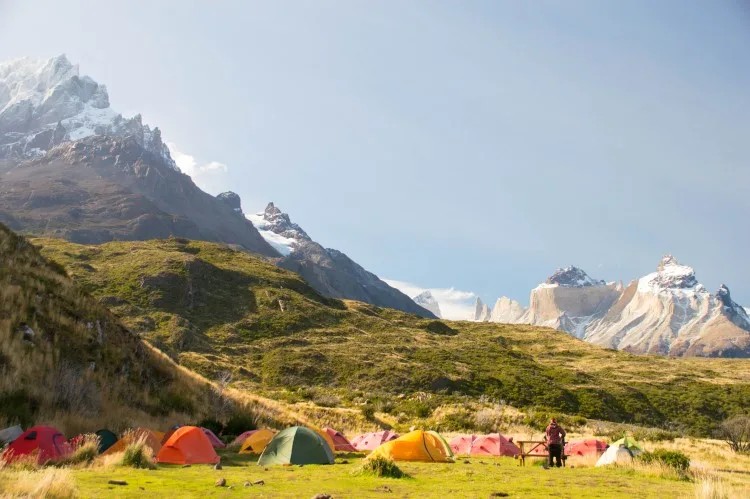
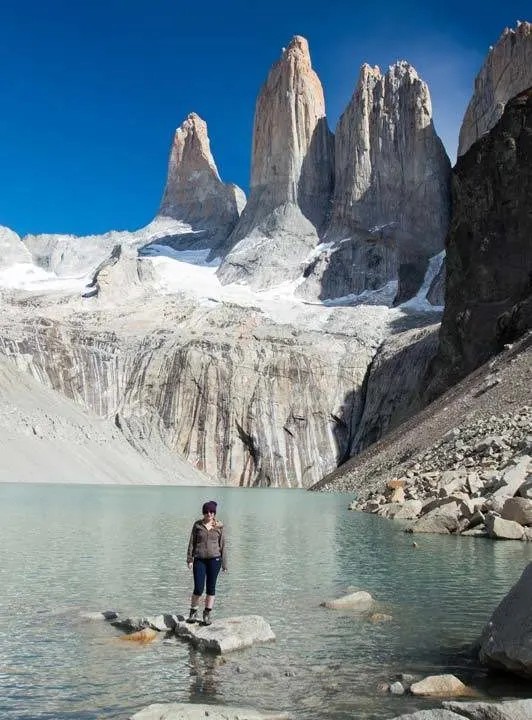
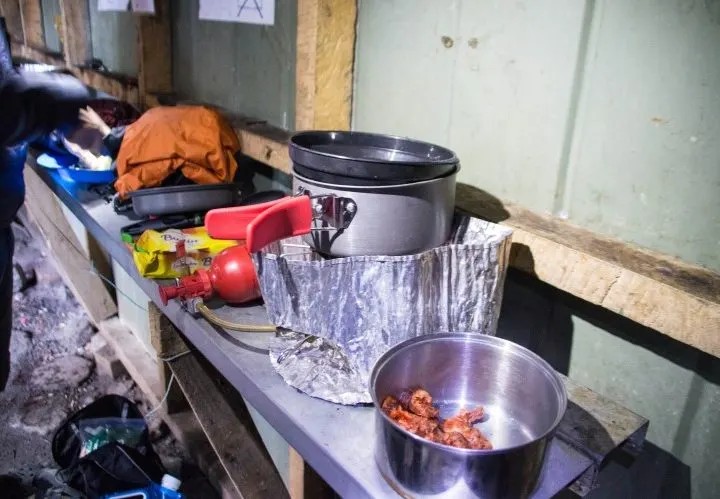
3.2. Food Breakdown
Budget approximately $12 USD per person per day for food if you bring your own supplies. When planning your food, consider options like:
- Breakfast: Oatmeal, granola, dried fruit, nuts.
- Lunch: Sandwiches with cheese, salami, or peanut butter; trail mix, energy bars, fruit.
- Dinner: Pasta, couscous, dehydrated meals, canned fish or meat, dried vegetables.
3.3. Time-Saving Tip for Booking Accommodation
Use Torres Hike to check accommodation availability and book directly, saving significant time compared to booking through individual campground websites.
4. Securing Campsite and Refugio Bookings
The process of booking refugios and campsites in Torres del Paine has evolved in recent years, and much of the information online is outdated.
- Complexity: The primary challenge lies in the necessity of using two different companies for campground and dorm reservations. This can be a tedious and frustrating process.
- Recommended Solution: Utilizing Torres Hike can save considerable time and effort. While a small fee is charged, the convenience of a consolidated booking platform is well worth it.
- Booking Alternatives: If you find campsites fully booked, explore alternative W trek options.
4.1. Alternative Options if Campsites are Fully Booked
- Consider Off-Season Travel: Hiking during shoulder seasons (November, March) may offer better availability and fewer crowds.
- Check for Cancellations: Keep monitoring booking websites for cancellations, which often occur closer to the date due to tour agencies releasing unconfirmed reservations.
- Contact Local Agencies: Local tour operators like Chile Nativo may have access to reserved spots or be able to arrange alternative itineraries.
5. Essential Equipment for a Self-Supported Trek
Completing the Torres del Paine W trek independently necessitates having the appropriate equipment.
- Comprehensive Packing Lists: Detailed equipment lists for both the O Circuit and general Patagonia travel provide valuable insights into necessary items.
- Camping Gear Investment: Consider investing in camping equipment if you plan to undertake other hikes or explore the Carretera Austral.
5.1. Key Equipment Considerations
- Tent: A lightweight, waterproof tent suitable for windy conditions.
- Sleeping Bag: A sleeping bag rated for temperatures around 0°C (32°F).
- Sleeping Pad: An inflatable or foam sleeping pad for insulation and comfort.
- Backpack: A 60-70 liter backpack to carry all your gear.
- Hiking Boots: Sturdy, waterproof hiking boots that are well broken-in.
- Rain Gear: Waterproof jacket and pants are essential due to unpredictable weather.
- Warm Layers: Fleece jacket, thermal underwear, and a hat and gloves for warmth.
- Cooking Gear: A portable stove, cooking pot, utensils, and fuel if you plan to cook your own meals.
- Water Filter or Purification Tablets: To ensure access to safe drinking water.
- Headlamp: For navigating campsites and trails in the dark.
- First Aid Kit: Including blister treatment, pain relievers, antiseptic wipes, and any personal medications.
5.2. Acquiring Camping Equipment
If you’re already traveling in Patagonia, you have several options for acquiring camping gear:
5.2.1. Purchasing Equipment in Punta Arenas or Puerto Natales
Both cities feature a selection of hiking and camping equipment stores. Punta Arenas, being a tax-free zone, typically offers more competitive prices.
- Cost: Expect to pay elevated prices for high-quality gear.
5.2.2. Renting Equipment from Puerto Natales
Renting equipment from Puerto Natales is a cost-effective alternative. Several establishments, such as Yaghan House and Lili Patagonico’s, offer affordable, good-quality gear.
- Cost: Rental can cost around $162 USD per person (based on two sharing) for five days.
- Important Note: Thoroughly inspect the equipment before committing to the rental.
5.2.3. Renting Equipment at Campsites
Renting gear at the campsites within Torres del Paine is the most expensive option.
- Cost: Expect to pay approximately $256 USD per person for equipment and $282 USD for full board for five days (based on two sharing).
6. Transportation from Torres del Paine to Puerto Natales
Accessing Torres del Paine National Park via public transportation is relatively straightforward.
- Bus Services: Several companies operate daily routes between Puerto Natales and Torres del Paine. A return ticket costs around $25 USD.
- Advance Booking: Booking your bus ticket at least a week in advance is recommended, particularly during peak season (December through February).
- Group Discounts: If traveling in a group, consider negotiating a discounted rate.
6.1. Bus Timetables from Puerto Natales
Buses typically travel from Puerto Natales to Laguna Amarga (for the eastern starting point of the W) before continuing to Pudeto (for the catamaran to the western starting point).
6.2. Timetables for Buses from Puerto Natales to Torres del Paine (East to South)
| Company Name | Leaves Puerto Natales | Arrives Laguna Amarga | Arrives Pudeto |
|---|---|---|---|
| Bus Sur | 6.45am | 8.45am | 9.45am |
| 7am | 9am | 10am | |
| 7.15am | 9am | 10.15am | |
| 12pm | 2pm | 3pm |
6.3. Bus Timetables from Torres del Paine
The following timetables outline bus departures from various stops within the park back to Puerto Natales. Book your bus tickets via Bus Sur’s website.
6.4. Timetables for Buses from Torres del Paine to Puerto Natales
| Company name | Leaves Pudeto | Leaves Laguna Amarga | Arrives Puerto Natales |
|---|---|---|---|
| Bus Sur | 10.30am | 11am | 1pm |
| 1.30pm | 3pm | 5.05pm | |
| 7pm | 8.20pm | 9.30pm |
7. Purchasing Park Entrance Tickets
Park entrance tickets must be purchased online in advance via pasesparques.cl. Download the QR code to your phone before entering the park, as internet connectivity is unreliable.
- Entrance Fees: The cost varies based on the duration of your stay. For stays up to three days, the fee is approximately $34 USD for adults. For stays longer than three days, the fee is approximately $48 USD for adults.
8. Torres del Paine W Trek Itineraries
Hiking the W trek independently allows for flexibility and cost savings. There is no chance that you’ll get lost. Believe me, the W trek is now so busy that (unfortunately) you see people all the time.
8.1. Map and Navigation
When entering the park, you’ll receive a Torres del Paine W trek map. However, this map lacks distance information. It’s strongly recommended to download Maps.me, a free app that marks all trails and enables distance calculation.
8.2. West to East: Five-Day Itinerary
Day One: Puerto Natales to Grey
- Distance: 11 kilometers (6.8 miles)
- Duration: 3-4 hours hiking
- Activities: Bus to Pudeto, ferry to Paine Grande, trek to Grey campsite.
Day Two: Grey to Paine Grande
- Distance: 18 kilometers (11 miles)
- Duration: 6-7 hours hiking
- Activities: Explore viewpoints near Grey Glacier, hike back to Paine Grande.
Day Three: Paine Grande to Francés
- Distance: 11.5 kilometers (6.8 miles) plus 9 kilometers (5.6 miles) for the extension to Mirador Británico)
- Duration: 4 hours hiking (7.5 hours with extension to Mirador Británico)
- Activities: Hike around Lake Nordernskjold, ascend to Mirador Francés and optionally Mirador Británico.
Day Four: Francés to El Chileno
- Distance: 17 kilometers (10.5 miles)
- Duration: 4-5 hours hiking
- Activities: Trek to El Chileno campsite, prepare for the early morning hike to the towers.
Day Five: El Chileno to Laguna Amarga and Puerto Natales
- Distance: 13 kilometers (8 miles) plus 8 kilometers (5 miles) for the hike from the Centro de Bienvenida to Laguna Amarga)
- Duration: 6 hours hiking (add an extra 1.5-2 hours for the hike to Laguna Amarga)
- Activities: Sunrise hike to the towers, return to El Chileno, hike to Laguna Amarga, bus to Puerto Natales.
8.3. West to East: Four-Day Itinerary
Day Zero: Puerto Natales to Paine Grande
- Activities: Bus to Pudeto, ferry to Paine Grande, set up camp.
Day One: Paine Grande to Paine Grande
- Distance: 22 kilometers (14 miles) plus 7 kilometers (4.3 miles) if you hike to the last viewpoint)
- Duration: 7-9 hours hiking
- Activities: Hike to Glacier Grey viewpoints, return to Paine Grande.
Day Two: Paine Grande to Frances
- Distance: 11.5 kilometers (6.8 miles) plus 9 kilometers (5.6 miles) for the extension to Mirador Británico)
- Duration: 4 hours hiking (7.5 hours with extension to Mirador Británico)
- Activities: Hike to Guardaria Italiano, ascend to Mirador Francés and optionally Mirador Británico.
Day Three: Frances to El Chileno
- Distance: 17 kilometers (10.5 miles)
- Duration: 4-5 hours hiking
- Activities: Trek to El Chileno campsite, prepare for the early morning hike to the towers.
Day Four: El Chileno to Laguna Amarga and Puerto Natales
- Distance: 13 kilometers (8 miles) plus 8 kilometers (5 miles) for the hike from the Centro de Bienvenida to Laguna Amarga)
- Duration: 6 hours hiking (add an extra 1.5-2 hours for the hike to Laguna Amarga)
- Activities: Sunrise hike to the towers, return to El Chileno, hike to Laguna Amarga, bus to Puerto Natales.
8.4. East to West: Five-Day Itinerary
Day One: Puerto Natales to Mirador Las Torres & Torres Central/Norte
- Distance: 18.4 kilometers (11.4 miles)
- Duration: 6-7 hours hiking
- Activities: Bus to Laguna Amarga, shuttle to Welcome Center, hike to Mirador Las Torres.
Day Two: Torres Central/Norte to Francés
- Distance: 14.5 kilometers (9 miles)
- Duration: 5.5 hours hiking
- Activities: Hike west, along Lago Nordernskjold, to Francés campground.
Day Three: Francés to Mirador Británico & Paine Grande
- Distance: 11.5 kilometers (6.8 miles) plus 9 kilometers (5.6 miles) for the extension to from Mirador Francés up to Mirador Británico
- Duration: 4 hours hiking (7.5 hours with extension from to Mirador Francés up to Mirador Británico)
- Activities: Ascend into the Francés Valley to Mirador Francés and optionally Mirador Británico.
Day Four: Paine Grande to Grey & Puerto Natales
- Distance: 11 kilometers (6.8 miles) plus six kilometers (3.7 miles) to reach rope bridges
- Duration: 4 hours hiking plus 1.5 hours to reach rope bridges
- Activities: Hike north to Grey, explore viewpoints, reach rope bridges.
Day Five: Grey to Paine Grande and Puerto Natales
- Distance: 11 kilometers (6.8 miles) plus 2.3 kilometers (1.4 miles) to the Cuernos Viewpoint
- Duration: 4 hours hiking
- Activities: Return to Paine Grande, ferry to Pudeto, bus to Puerto Natales.
8.5. East to West with Sunrise at the Towers: Five-Day Itinerary
Day Zero: Puerto Natales to El Chileno
- Distance: 5 kilometers (3miles)
- Duration: 2 hours hiking
- Activities: Bus to Laguna Amarga, shuttle to Welcome Center, hike to El Chileno campground.
Day One: El Chileno to Mirador Las Torres and then Los Cuernos
- Distance: 19.4 kilometers (12 miles)
- Duration: 6.5 hours hiking
- Activities: Sunrise hike to the towers, trek alongside Lago Nordenskjöld to Los Cuernos.
Day Two: Los Cuernos to Paine Grande
- Distance: 17.5 kilometers (10.8 miles) from Los Cuernos to Mirador Británico and 7 kilometers (4.3 miles) from Guardería Italiano to Paine Grande
- Duration: 6.5 hours hiking from Francés to Mirador Británico and 2.5 hours from Guardería Italiano to Paine Grande
- Activities: Hike to Guardería Italiano, ascend to Mirador Británico, hike to Paine Grande.
Day Three: Paine Grande to Grey and back to Paine Grande
- Activities: Hike from Paine Grande to Grey
- From the campsite, an additional one kilometre north through the forest brings you to two viewpoints lying over a kilometre from the glacier’s snout.
Continue a further 2.5 kilometres (around a one-hour hike) along the path along the edge of the glacier to reach a series of two rope bridges hanging over ravines.
Day Four: Paine Grande to Puerto Natales
- Activities: Return to Paine Grande along the same path.
9. Essential Tips for a Successful Self-Guided Trek
Following these tips from CONDUCT.EDU.VN can help ensure a smooth and fulfilling self-guided experience:
9.1. Top Equipment Tips
- Extra Cord for Tent Attachment: Camping at Francés, Los Cuernos, and El Chileno involves securing tents on wooden platforms.
- Versatile Clothing: Pack a range of warm and waterproof clothing to cater to unpredictable weather conditions.
- Entertainment: Bring a book or cards for the evenings.
- Lightweight Tent: A lightweight tent significantly eases the burden of carrying gear.
- 60-Liter Rucksack: A 60-liter rucksack should suffice if carrying all your equipment.
- Dry Bags: Pack all clothing in dry bags to safeguard against moisture.
- Rucksack Cover: Use a rucksack cover to protect your bag from rain.
9.2. Top Food Tips
- Punta Arenas Supermarkets: A wider and cheaper selection of food is available in Punta Arenas compared to Puerto Natales.
- Trekking Food: Consider bringing trekking food for convenience.
- Zip-Lock Bags: Repackage food in zip-lock bags to minimize weight.
- Basic Staples at Campsites: You can purchase basic staples at Paine Grande, Grey, Francés, and El Chileno.
- Drinking Water: Water is accessible from glacier meltwater streams and campsite taps. Bring a Steripen or Grayl water filter for purification.
- Multi-Day Trek Food Expertise: Refer to resources for guidance on food packing for multi-day treks.
9.3. Other Tips
- Chilean Pesos: Bring Chilean pesos as cards are not widely accepted in the park.
- Catamaran Ferry: Allocate $35 USD for the catamaran ferry.
9.4. Camping in Torres del Paine
The following summarizes some of the main points about booking campsites and refugios in Torres del Paine for the W trek, but you can get a full overview of how to book campsites in Torres del Paine with this article updated for the current season.
If you want to save time, the website Torres Hike can show you the availability of accommodation and allows you to book it directly through them, rather than having to go via the Vertice Patagonia and Las Torres (previously known as Fantastico Sur) websites. All you need to do is plug in your dates and it’ll show you which campgrounds and refugios are available – saving you LOTS of time. You can then book directly with them, rather than having to try and book through the other websites!
9.5. Reservations with Las Torres and Vertice Patagonia
You will need to book your campsites in Torres del Paine in advance. For example, in August 2022, many of the campsites and refugios were fully booked for December through February 2023, which just shows how far in advance it gets booked up.
Before you start panicking, what happens each year is that reservations free up again in September/October, probably due to the fact that tour agencies in Puerto Natales make mass reservations for the high season, and then cancel them when they don’t fill the bookings.
If you need anything planned well in advance, then this isn’t going to suit your plans. If your plans are a little more open and you can wait until closer until the time (and keep checking back to see if any spots have opened up), then you should still be able to hike the W during these months.
My recommendation would be to hike outside of these months anyway (November or March) to avoid the crowds as much as possible, but either way, you still MUST SECURE YOUR RESERVATIONS with Las Torres (Francés, Los Cuernos, El Chileno) and Vertice Patagonia (Paine Grande and Grey).
If you’re trying to get a space last-minute, you can always pop into either of their offices in Puerto Natales and see if they can book you in. I’ve heard of people having success with this with only a day or two’s notice.
9.6. Reservations with CONAF
For thecurrent season and foreseeable future, all of the CONAF campsites remain closed.
10. Elevate Your Self-Guided Trekking Experience
Enhance your independent Torres del Paine W trek by incorporating these modifications:
10.1. Opt for Full Board at Los Cuernos
Consider staying overnight at Los Cuernos, which offers full board options.
- Benefits: Reduced backpack weight due to included meals.
- Cost: Approximately $88 USD per person for full board.
10.2. Book Full Board and Accommodation
You can arrange full board and accommodation at each campsite.
- Convenience: Eliminates the need to carry gear and supplies.
By following this guide, you can confidently plan and execute a remarkable self-guided adventure in Torres del Paine National Park.
FAQ: Hiking Torres del Paine Without a Guide
1. Is it safe to hike Torres del Paine without a guide?
Yes, it’s generally safe. The trails are well-marked and popular, especially during peak season. However, it’s essential to be prepared with the right equipment, knowledge of the route, and awareness of weather conditions.
2. What are the main challenges of hiking independently?
The main challenges include securing campsite reservations, navigating without a guide, carrying all your gear, and being prepared for unpredictable weather.
3. Do I need to speak Spanish to hike Torres del Paine?
While it’s helpful, it’s not essential. Many staff at refugios and tour operators speak English. However, knowing some basic Spanish phrases can enhance your experience and interactions with locals.
4. How far in advance should I book campsites?
It’s recommended to book campsites several months in advance, especially if you’re traveling during the high season (December to February). Campsites can fill up quickly.
5. What kind of physical fitness is required?
You should have a moderate level of fitness. The W trek involves hiking 10-20 kilometers per day with a heavy backpack. Practice hikes before your trip are highly recommended.
6. Can I rent camping equipment in Puerto Natales?
Yes, there are several rental shops in Puerto Natales that offer tents, sleeping bags, cooking equipment, and other essential gear.
7. What should I do in case of an emergency?
Familiarize yourself with emergency procedures and carry a first-aid kit. There are park rangers and rescue services available, but response times can vary depending on your location within the park.
8. How do I get from Puerto Natales to Torres del Paine?
You can take a bus from Puerto Natales to the park entrance. Several companies offer daily services during the trekking season.
9. Are there any restrictions on where I can camp?
Yes, you must camp only in designated campsites. Wild camping is not allowed in Torres del Paine National Park.
10. What is the weather like in Torres del Paine?
The weather in Torres del Paine is highly unpredictable. Be prepared for strong winds, rain, and fluctuating temperatures, even in summer. Layering your clothing is essential.
Planning a self-guided trek in Torres del Paine can be a rewarding experience, offering a sense of accomplishment and connection with nature. By preparing thoroughly and understanding the challenges, you can ensure a safe and unforgettable adventure.
For more detailed information and personalized guidance on planning your ethical travel adventures, visit CONDUCT.EDU.VN. Our team is dedicated to providing comprehensive resources and support to help you make informed decisions and explore the world responsibly. Contact us at 100 Ethics Plaza, Guideline City, CA 90210, United States or Whatsapp: +1 (707) 555-1234. Let conduct.edu.vn be your trusted partner in creating meaningful and sustainable travel experiences.